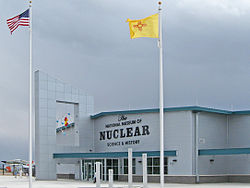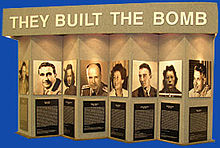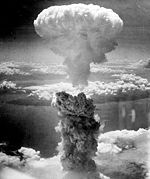- National Museum of Nuclear Science & History
-
Coordinates: 35°03′58″N 106°32′02″W / 35.0660°N 106.5339°W
National Museum of
Nuclear Science & History
Established 1969 (National Atomic Museum)
2009 (current)Location 601 Eubank at Southern Blvd
Albuquerque, New Mexico
(505) 245-2137Type Aviation and science museum Website http://www.nuclearmuseum.org/
The National Museum of Nuclear Science & History (formerly named National Atomic Museum) is a national repository of nuclear science information chartered by the 102nd United States Congress under Public Law 102-190,[1] and located in Albuquerque, New Mexico. "The mission of the National Atomic Museum is to serve as America's resource for nuclear history and science. The Museum presents exhibits and quality educational programs that convey the diversity of individuals and events that shape the historical and technical context of the nuclear age."[2]
Contents
History
The Museum was originally sited in 1969 on the grounds of Kirtland Air Force Base in an old 90 mm anti-aircraft gun repair facility, and named "Sandia Atomic Museum".[3] It was the result of a six-year effort to establish a museum to tell the story of the base and the development of nuclear weapons, and was staffed by United States Air Force (USAF) personnel with help from Sandia National Laboratories (SNL). In 1973, the Museum name changed to "National Atomic Museum", but it did not yet have a national charter.
In 1985, the United States Department of Energy (DOE) became responsible for the Museum, and the staff became DOE employees. In 1991 the Museum received its charter as a national museum and its mission expanded to include aspects of nuclear science and history beyond the manufacturing of nuclear weapons. The Museum also became affiliated with the Smithsonian Institution. In 1992 the National Atomic Museum Foundation (NAMF) was created to act as a supporting organization for the Museum and reduce the financial burden on taxpayers. DOE transferred Museum operation to SNL in 1995, and Museum staff became SNL employees.
After the terror attacks in September 2001, increased security restricted public access to the Museum's on-base site and forced relocation to a former REI store in Old Town Albuquerque's museum district. In 2005, SNL transferred operational responsibility to NAMF. SNL employees working as museum staff moved to other positions within Sandia. The Museum hired new staff who became employees of NAMF.
When the Museum relocated to Albuquerque's museum district, the site had inadequate space for outdoor exhibits. In January 2005, NAMF asked DOE/NNSA (National Nuclear Security Administration) for 12 acres (4.9 ha) of land at the intersection of Eubank and Southern Boulevards in southeast Albuquerque for construction of a new museum. In October 2006 a formal Land Use Agreement was signed with SNL as Grantor and NAMF as Grantee. Ground was broken and construction was begun. Museum staff documented its construction project via a blog[4] and a Flickr gallery[5] where photos were posted weekly to show the building's progress.
The new Museum opened on April 4, 2009 in its new location under the new name National Museum of Nuclear Science & History.[6]
Funding for construction came from multiple sources, including:
- $5 million in Federal funds for design and construction
- $1 million transferred from the State of New Mexico to the City of Albuquerque for infrastructure
- $2.63 million from corporations
- $25 thousand from foundations
- $500 thousand from individual contributions
The new facility incorporates 13 permanent indoor exhibit areas, two classrooms, a theater, library and conference room, a gallery for temporary exhibits, and the Museum's store in 30,000 sq ft (0.28 ha). of space. The site provides 9 acres (3.6 ha) of outdoor space for exhibits of military aircraft, missiles, vehicles, and the sail of the USS James K. Polk nuclear submarine.
Museum operating costs of approximately $1M annually are provided by NAMF, and received from three primary sources: Lockheed Martin ($500K), SNL ($250K), and Museum revenues ($250K) from admissions, NAMF memberships, grants, events/rentals, and Museum store proceeds.[3]
Exhibits and displays
- Section source: NMoNSH[7]
The Museum is dedicated to preserving and presenting information about scientific, historic, and cultural aspects of the Atomic Age. Permanent exhibits focus on:
Chronology of Nuclear History — the history of early nuclear science research, including:
- an account of earliest insights into the atomic structure of matter and the elements
- an extensive biographical display of Madame Marie Curie
- poignant discussion of early victims of unknowning radiation exposure such as Sister Blandina, a German nun who worked as an X-ray radiographer and subsequently died from improper radiography operating practices.
Waging Peace — The Challenge of Nuclear Stewardship — An extensive timeline display that explores arms control efforts from the Medieval and Middle Ages (Peace and Truce of God), through World War I, through the rearmament of Germany and World War II, to nuclear weapons non-proliferation treaties during the Cold War.
They Built the Bomb — A biographical information display about Manhattan Project scientists, engineers, and administrators such as Emilio G. Segrè, J. Robert Oppenheimer, William S. Parsons, and Lt. Gen. Leslie Groves; and lesser-known technicians and support personnel (especially women) such as Elizabeth "Diz" Riddle Graves, Dorothy McKibbin, and Eleanor "Jerry" Roensch (née Stone).
The Decision to Drop — A series of displays striving for objective examination of the history leading up to, and the policy decisions regarding, deployment of the first nuclear weapons code-named Little Boy and Fat Man. Panels feature reflection on the consequences of their use from viewpoints of both sides of the debate (see Debate over the atomic bombings of Hiroshima and Nagasaki).
The exhibit includes text of comments by Manhattan Project staff (including a contentious Edward Teller statement advocating a high-altitude night-time demonstration detonation over Tokyo to precipitate Japanese surrender), text of statements by Japanese politicians and military leaders, a copy of the petition protesting use without warning submitted by nuclear physicist Leó Szilárd, and photographs from the Hiroshima Peace Memorial Museum. The display also features video footage of the reminiscences of Col. Paul Tibbets (pilot of the Enola Gay, the B-29 bomber that dropped the atomic bomb on Hiroshima, Japan), and coverage of the emotion the surrender of Japan produced in the United States.
Cold War — An examination of the strategic conflict between the United States and the USSR in the second half of the 20th Century, through US nuclear testing in the Marshall Islands and at the Nevada Test Site, Soviet nuclear development, the October 1962 Cuban Missile Crisis, and leading to the eventual collapse of the Soviet Union.
Palomares — An extensive accounting of the January 17, 1966 Palomares B-52 crash — a mid-air collision between two USAF aircraft (a B-52 bomber and a KC-135 tanker) over Palomares, Almería resulting in radioactive contamination following the accidental dropping of four hydrogen bombs.
Nuclear Medicine: Seeing is Healing — A display of early and modern medical equipment using principles of nuclear physics.
Little Al's Lab — An area presided over by an animatronic version of Albert Einstein, provides hands-on science encounter activities for children.
Power Up — A series of displays focusing on civilian use of nuclear power including:
- history of nuclear reactors and discussion of their engineering principles
- examination of nuclear power accidents, safety engineering, and waste treatment/storage
- models of the American Palo Verde Nuclear Generating Station and French Superphénix Fast breeder reactor
- a model of the NS Savannah, the first nuclear-powered merchant ship
- nuclear energy as one part of a spectrum of alternative energy-producing methods
What's Hot, What's Not — Radiation in the World Around Us — A display of everyday items and activities that expose people to ionizing radiation.
Traveling Exhibits — An area devoted to different temporary exhibits.
Both self-guided and docent-led tours are available.[8]
Noteworthy artifacts
- replicas of Little Boy and Fat Man
- assorted modern nuclear bombs and warheads
- a WE.177 bomb (British nuclear weapon deployed from the 1960s until 1998)
- a Norden bombsight
- two of the actual bomb casings from the Palomares hydrogen bombs incident
- a collection of items reflecting daily life at Los Alamos during the Manhattan Project.
- an assortment of kitsch and products exemplifying the impact of the Atomic Age on US culture.
- an early flouroscope X-ray device
- a shoe-fitting fluoroscope from the 1920s
- a PRISM 2000 XP Gamma Camera (example of more modern nuclear imaging technology)
- a display of nuclear and homeopathic medical quackery artifacts
- an extensive model collection of military aircraft and other vehicles
- a Lego model of Chicago Pile-1
Controversy arose [9] when the Museum relocated to the Old Town museum district and erected its Redstone rocket at the corner of 20th Street and Mountain Road NW.[10] Some people saw the erecting of the rocket in an area of the city frequented by lovers of the arts and families with children as emblematic of pervasive Military-industrial complex influence in Albuquerque and New Mexico. Others saw the rocket as relevant to accurate portrayal of New Mexico's involvement in the nuclear age.[11] With the opening of the new museum, the Redstone rocket has been relocated to the Eubank site.
Aircraft on display
- A-7 Corsair II Navy Bureau number 154407
- B-29 Superfortress USAF serial number 45-21748
- B-52B Stratofortress (originally RB-52B) USAF serial number 52-013
- F-105D Thunderchief USAF serial number 61-0107
Science education and community activities
The Museum conducts year-round primary, secondary, and adult education programs both in-house and via outreach using the Up'n'Atom Mobile. Professional educator development programs support New Mexico school curriculum standards.[12] The museum hosts guest speakers, annual special events, and week-long youth science camps in the summer. Rental space is available for birthdays and other occasions.
In popular culture
The former museum site was used in the 2008 AMC television show Breaking Bad in a storyline as a drug drop area. It appeared in several scenes.
References
- ^ Text of Public Law 102-190
- ^ National Museum of Nuclear Science & History: Text of Museum's Mission Statement
- ^ a b Powerpoint presentation on Museum history, Foundation funding, and new construction.
- ^ Construction project blog
- ^ Flickr gallery of Museum construction
- ^ "Nuclear museum's new site set to open Sat.". New Mexico Business Weekly. 2009-04-02. http://www.bizjournals.com/albuquerque/stories/2009/03/30/daily54.html. Retrieved April 25, 2009.
- ^ National Museum of Nuclear Science & History: Exhibits Official site
- ^ National Museum of Nuclear Science & History: List of available tours
- ^ Global Network Against Weapons and Nuclear Power in Space, December 13, 2003 — Albuquerque War Missile Protest Alert!
- ^ Google Map view of Museum — see street view showing base of rocket.
- ^ Albuquerque Tribune editorial, 19 Feb 2008.
- ^ National Atomic Museum Education & Outreach website
External links
Wikimedia Commons has media related to: - National Museum of Nuclear Science & History — official site
- Trinity [Atomic Test] Site: The 50th Anniversary of the Atomic Bomb (an e-book at Project Gutenberg) Works by National Atomic Museum at Project Gutenberg
- A Visitor's Pictorial Web Site of the old Museum at Kirtland AFB. National Atomic Museum Pictorial[dead link], Kirtland AFB.
 State of New Mexico
State of New MexicoSanta Fe (capital) Topics Delegations · Geography · Government · History · Landmarks · Military · Natural history · New Mexicans · Settlements · Transportation · Tribes · Visitor attractions
Society Culture · Demographics · Economy · Education · Politics
Regions Cities Alamogordo · Albuquerque · Artesia · Carlsbad · Clovis · Corrales · Deming · Española · Farmington · Gallup · Grants · Hobbs · Las Cruces · Las Vegas · Los Alamos · Los Lunas · Lovington · Portales · Raton · Rio Rancho · Roswell · Ruidoso · Santa Fe · Silver City · Socorro · Sunland Park · Taos · Tucumcari
Counties Bernalillo · Catron · Chaves · Cibola · Colfax · Curry · De Baca · Doña Ana · Eddy · Grant · Guadalupe · Harding · Hidalgo · Lea · Lincoln · Los Alamos · Luna · McKinley · Mora · Otero · Quay · Rio Arriba · Roosevelt · Sandoval · San Juan · San Miguel · Santa Fe · Sierra · Socorro · Taos · Torrance · Union · Valencia
City of Albuquerque, New Mexico  Richard J. Berry, Mayor
Richard J. Berry, Mayor
History • City Council • Mayors
Neighborhoods • Transportation • Architecture • Famous Residents
Economy • Arts and Culture • Sports • Educational InstitutionsBernalillo County • North Valley • Rio Rancho • South Valley Categories:- Museums in Albuquerque, New Mexico
- Aerospace museums in New Mexico
- Nuclear technology in the United States
- Nuclear history of the United States
- American national museums in New Mexico
- Military and war museums in New Mexico
- Science museums in New Mexico
Wikimedia Foundation. 2010.




